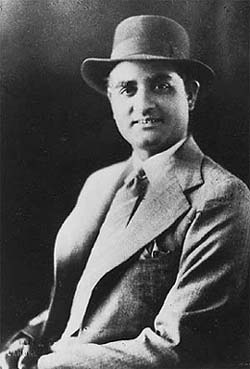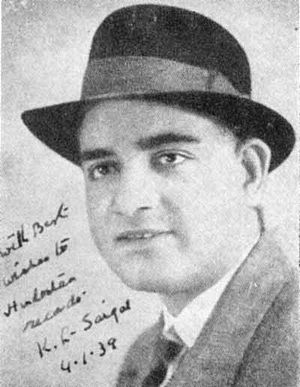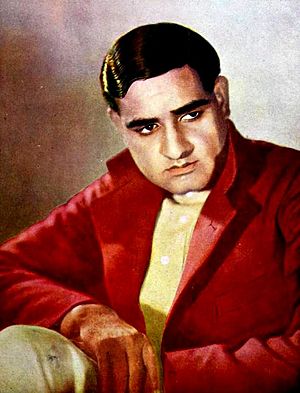K. L. Saigal facts for kids
Quick facts for kids
K.L. Saigal
|
|
|---|---|
 |
|
| Background information | |
| Birth name | Kundanlal Saigal |
| Born | 11 April 1904 Jammu, Jammu and Kashmir, British India (present-day Jammu and Kashmir, India) |
| Died | 18 January 1947 (aged 42) Jullundur, Punjab, British India (present-day Punjab, India) |
| Genres | Playback singing |
| Occupation(s) | Singer, actor |
| Years active | 1932–1947 |
Kundan Lal Saigal, known to many as K. L. Saigal (born April 11, 1904 – died January 18, 1947), was a famous Indian singer and actor. He is often called the very first superstar of the Hindi film industry. During his time, this film industry was based in Calcutta, but today it is in Bombay.
Saigal had a very special voice that was a mix of deep and soft tones. Many singers who came after him looked up to his voice as the best. Even today, his early recordings, made with old technology, show how amazing his voice was.
Contents
Early Life and Beginnings
Saigal was born on April 11, 1904, in Jammu, into a Punjabi family. His father, Amarchand Saigal, worked for the Maharaja Pratap Singh of Jammu and Kashmir. His mother, Kesarbai Saigal, was a very religious Hindu lady who loved music.
She often took young Kundanlal to religious events where traditional songs like bhajans, kirtans, and shabads were sung. These songs were based on classical Indian music. Saigal was the fourth of five children. He didn't go to school for very long. As a child, he sometimes played the Sitar in local plays called Ramlila.
Saigal left school and took on different jobs. He worked as a railway timekeeper and later as a salesman for the Remington Typewriter Company. This job allowed him to travel to many parts of India. During his travels, he met Mehrchand Jain in Lahore, who became a good friend. They both later moved to Calcutta. Mehrchand encouraged Saigal to follow his passion for singing. Saigal also worked briefly as a hotel manager, but his love for singing always grew stronger.
Becoming a Star at New Theatres
In the early 1930s, a music director named Harishchandra Bali brought K.L. Saigal to Calcutta. He introduced Saigal to R. C. Boral, another important music figure. Boral was very impressed with Saigal's talent. Saigal then got a job at B. N. Sircar's film studio, New Theatres, in Calcutta. There, he met other famous artists like Pankaj Mullick.
Saigal's first record with Punjabi songs was released by the Indian Gramophone Company. Harishchandra Bali was his first music director for these songs. Saigal's first films were Mohabbat Ke Ansu, Subah Ka Sitara, and Zinda Lash, all released in 1932. These films were not very successful. For his first three films, he used the name Saigal Kashmiri. After that, he used his real name, Kundan Lal Saigal (K. L. Saigal).
In 1933, Saigal sang four bhajans for the film Puran Bhagat. These songs became very popular across India. Other films followed, like Yahudi Ki Ladki and Chandidas. The famous singer Lata Mangeshkar once said that she wanted to marry K.L. Saigal after watching him in Chandidas (1934).
In 1935, Saigal played a very important role in the film Devdas. This movie was based on a famous novel by Sarat Chandra Chattopadhyay. Saigal's songs from Devdas, like "Balam Aaye Baso Moray Man Mein," became hits all over the country.
Saigal learned Bengali very well and acted in seven Bengali films for New Theatres. Even the great poet Rabindranath Tagore allowed Saigal, who was not Bengali, to sing his songs. Saigal became very loved in Bengal because of his 30 Bengali songs.
His work with New Theatres continued with many successful films. These included President (1937), Dharti Mata (1938), and Street Singer (1938). In Street Singer, Saigal sang the song "Babul Mora Naihar Chhooto Jaye" live while the camera was rolling. This was special because, by then, most songs were recorded separately and then added to films.
Moving to Bombay and Later Years
In December 1941, Saigal moved to Bombay to work with Ranjit Movietone. There, he acted and sang in many successful films. Bhakta Surdas (1942) and Tansen (1943) were big hits. Tansen is still remembered for Saigal's performance of the song "Diya Jalao." In 1944, he went back to New Theatres to finish the film My Sister, which featured popular songs like "Do Naina Matware."
K.L. Saigal passed away on January 18, 1947. Before his death, he recorded three more popular songs for the film Shahjehan (1946), with music by Naushad Ali. These songs included "Mere Sapnon Ki Rani" and "Jab Dil Hi Toot Gaya." Parwana (1947) was his last film, released after he passed away.
Saigal was married to Asha Rani and had three children: a son named Madan Mohan and two daughters, Nina and Bina. He also adopted his elder brother's daughter, Durgesh Nandani.
In his fifteen-year career, Saigal acted in 36 films. Most were in Hindi, but he also made films in Bengali and one in Tamil. He sang 185 songs in total, including film songs and non-film songs. His non-film songs included bhajans and ghazals. He sang poems by famous poets like Ghalib.
Many famous singers who came after him, like Kishore Kumar, Mohammad Rafi, Lata Mangeshkar, and Mukesh, looked up to K.L. Saigal as their teacher and inspiration.
Discography
Filmography
| Year | Title | Role | Notes |
|---|---|---|---|
| 1932 | Mohabbat Ke Ansu | Debut Movie. | |
| Zinda Lash | |||
| Subah Ka Sitara | |||
| 1933 | Yahudi Ki Ladki | Prince Marcus | First hit of K.L Saigal |
| Rajrani Meera | |||
| Puran Bhagat a.k.a. The Devotee | Puran | ||
| Dulari Bibi | |||
| 1934 | Daku Mansoor | ||
| Mohabbat Ki Kasauti | Arup | In Hindi version. | |
| Chandidas | Chandidas | ||
| 1935 | Karwan-E-Hayat | Pervez | |
| Devdas (Bengali) | Guest at Chandramukhi's House | Bengali | |
| Devdas (Hindi) | Devdas | First superhit of K.L Saigal | |
| 1936 | Pujarin | Jibananda | |
| Karodpati a.k.a. Millionaire | |||
| 1937 | Didi (Bengali) | Prakash | as Kundan Lal Saigal, Bengali |
| President a.k.a. Badi Bahen | Prakash | Hindi version of Didi | |
| 1938 | Street Singer | Bhalwa | |
| Sathi | Bhulwa | Bengali version of Street Singer | |
| Jiban Maran | Mohan | Bengali version of Dushman | |
| Dharti Mata | Ashok | ||
| Deshar Mati | Ashok | Bengali | |
| 1939 | Dushman | Mohan | |
| 1940 | Zindagi | Ratan | |
| 1941 | Parichay | Composer | Bengali version of Lagan |
| Lagan | Composer | ||
| 1942 | Bhakta Surdas | as K.L.Saigal | Debut in Bombay |
| 1943 | Tansen | Tansen | as Saigal |
| 1944 | My Sister | Ramesh | |
| Bhanwara | |||
| 1945 | Tadbir | Kanhaiyalal | |
| Kurukshetra | |||
| 1946 | Shahjehan | Sohail | |
| Omar Khaiyyam | |||
| 1947 | Parwana | Inder |
See also
- Bollywood songs




